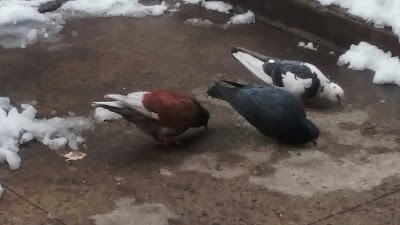Biset or Wild Rock Pigeon Columba livia. Rocky and precipitous cliffs, particularly those of the sea-coast perforated by caverns, either originating in the nature of the rock itself, or worn and hollowed out by the action of the waves, are the appropriate retreats of the pigeon in its wild or natural state.
In this condition it possesses a very extensive geographical distribution throughout the maritime districts of the world, being abundant in most of the Rocky Islands belonging to Africa and Asia, and in those of the Mediterranean, where it swarms in incredible numbers. Upon oar own coasts it is found wherever the nature of the barrier suits its habits, extending as far as the Orkneys, where Low describes it as the inhabitant of all their numerous and extensive caves, retiring to their inmost recesses, and generally beyond the situations selected for nidification by the auks, gulls, and other aquatic fowl.
It is also met with upon the northern and western coasts of Sutherland, the perforated and cavernous rocks which gird the eastern side of Loch Eriboll, and those of the limestone district of Durness, furnishing suitable places of retreat, and again upon the eastern coast of Scotland, it is seen about the rocky steeps of the Isle of Bass, and the bold promontory of St Abb's Head.
The Common Rock Dove found on Manhattan's Upper Westside at 90th street and Broadway Match 14, 2011.
Image License: I, (sookietex) the creator of this work, hereby release it into the public domain. This applies worldwide. In case this is not legally possible, I grant any entity the right to use this work for any purpose, without any conditions, unless such conditions are required by law.
If These image is subject to copyright in your jurisdiction, i (sookietex) the copyright holder have irrevocably released all rights to it, allowing it to be freely reproduced, distributed, transmitted, used, modified, built upon, or otherwise exploited in any way by anyone for any purpose, commercial or non-commercial, with or without attribution of the author, as if in the public domain.
The supposition of many of our ornithologists that this and the preceding species were identical, has led to considerable confusion in their writings, and produced a mixed sort of description strictly applicable to neither. The distinctions, however, between the species, even in regard to plumage, are such, that, if attended to, no mistake can well arise, and if accompanied by a corresponding attention to their respective habits, the difference becomes still more apparent and convincing.
In one we have a bird the frequenter and inhabitant of the woods, where it roosts, breeds, and perches with security and ease upon the trees, like the ring pigeon and other arboreal species; in the other, an inhabitant of caves and the holes of rocks, and which is never known, under any circumstance, to affect the forest or perch upon a tree.
But the rock or wild pigeon is better known to our readers as the inhabitant of the pigeon-house, or, as it is frequently called, the dove-cot, buildings erected expressly for the purpose of containing colonies of these birds. In this state, where they enjoy a perfect freedom of action, and are nearly dependant upon their own exertions for support, they can scarcely be called reclaimed, much less domesticated.
Man, indeed, has only taken advantage of certain habits natural to the species, and by the substitution of an artificial for a real cavern, to which the pigeonhouse may be compared, has, without violating or at least greatly infringing upon its natural condition, brought it into a kind of voluntary subjection, and rendered it subservient to his benefit and use.
In its natural state, the plumage of the pigeon is as follows :—Bill blackish-brown ; the nostril membrane red, sprinkled, as it were, with a white powder. The irides pale reddish-orange. The head and throat are bluish-gray. The sides of the neck and upper part of the breast are dark lavender-purple, glossed with shades of green and purplish-red. The lower part of the breast and abdomen are bluish-gray.
The upper mandible and wing-coverts are blue-gray. The greater coverts and secondaries are barred with black, and form two broad and distinct bars across the closed wings. The lower part of the back is white ; the rump and tail-coverts bluish-gray. The tail is of a deep gray, with a broad black bar at the end. The legs and feet are pale purplish-red. When closed, the wings reach within half an inch of the end of the tail.
TEXT CREDIT: Pigeons By Prideaux John Selby, Andrew Crichton

















2 comments:
Thanks for posting this! Came looking for pigeon public domain pics to go on items about our village in the village paper Omemee Pigeon eFlyer Even saw some interesting ads. Well worth the visit.
Glad we could be of help :D Thanks for stopping by
Post a Comment